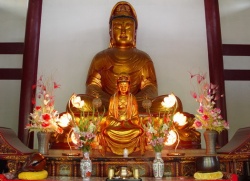Altar
Click here to see other articles relating to word Altar
Altar: The altar can consist of several groups of objects. Formally, the altar consists of three objects representing the Body, speech, and mind of The Buddha. A statue of a Buddha or Bodhisattva placed in the center.
A sacred text representing the speech of The Buddha; this is wrapped in maroon or yellow cloth and placed on the left side. On the right side of the altar, a Stupa represents the mind of The Buddha. Pictures may be used as substitutes for all of these objects.
altar (gan 龕)
The basic meaning of the word gan in the context of East Asian Buddhist is "stupa," or more specifically, the space within a stupa where relics of the Buddha or an eminent monk are enshrined. By extension, gan came to refer to stupa-shaped coffins that are used in the funerals of monks and lay people, and to the stupa-shaped niches or alcoves that are used to enshrine a variety of Buddhist images (e.g bodhisattvas, ancestral teachers, devas).
Because those images are the foci of prayers and offerings, the alcoves (gan 龕) that house them may aptly be called "altars." The Sacred Monk's altar (shōgan 聖龕) found in the sangha halls (sōdō 僧堂) and meditation halls (zendō 禪堂) of Zen monasteries is usually a roofed alcove that is enclosed on three sides and has a stupa-shaped opening in front. "stupa"
